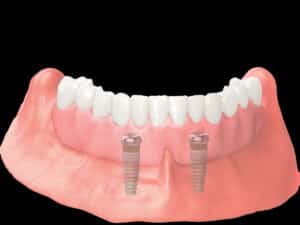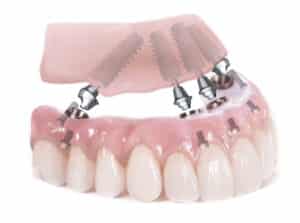A little more than 100 years ago, the average life expectancy in the United States was only in the 40s! Over the last century our ability to stay healthy and well has doubled that and today, if you are otherwise healthy and in your 60s, you are likely looking at 3+ decades! That means that your health has never been more important to your happiness!

Fortunately, along with the improvements in medicine, we have seen dramatic improvements in dental health too! We are long past the days of pulling a tooth because it has a cavity and the reality is while it was a given that if you lived long enough, you would end up with dentures, today that simply isn’t true. In fact, today even if you have to have all your teeth removed, there is the ability to replace them with secure and aesthetic teeth that don’t come in and out!
Even with all the advanced approaches and techniques, sometimes teeth have to come out and sometimes dentures are an option. We will talk through some of the options if you are in that situation.
A Traditional Denture
The Good News. The traditional solution has been to make a plastic set of teeth that sort of suctions into the mouth and after a period of adjusting to how to eat with the floating teeth in your mouth, most people accommodate reasonably well. Unfortunately, even with a well-made denture, 20% of people report being able to eat better without their teeth!!
The Risk. There is also the impact it has on how and what you eat. While the upper teeth can be pretty stable, the lower teeth float all over the place and people with dentures take about 25% more GI medication than people without. This is made worse by the fact that not having teeth accelerated bone loss and after only 20 years in a lower denture, it is not at all uncommon for the nerve to be exposed and jawbone to be very thin and prone to breaking easily.
The Reality. While the denture teeth do look like teeth in a photo, they really aren’t a substitute for teeth at all. Not only do they not support the bone, but the dentures actually accelerate bone loss. The amount of force you can bite with drops from 200 – 1000 psi down to about 3-6! This means you can’t eat the foods you want to and should anymore and are forced to just eat the food you can. In most cases, traditional dentures are little more than a dental wig and they get in the way of enjoying a healthy and happy life.
Snap-in Dentures

The Good News. The upper conventional denture can often be built so that it works well and stays still throughout the day. As long as the lower teeth are stable and secure, it can even eat pretty well. With a SNAP-IN denture, we can add a couple implants on the lower arch and actually snap the lower teeth in place. They are still supported by the jawbone and gum tissue, but they are stable and feel and function much more like teeth than a traditional lower denture. The majority of people are significantly happier if the lower denture has a pair of implants and snaps to hold it still and with today’s technology, that is the minimal standard of care.
The Risk. With the current implant technology, there aren’t many times that a pair of implants can’t make a massive difference in comfort. Unfortunately, over time, the bone will still change and the dentures will need to be remade. The implants will preserve the bone where they are, but the rest of the jaw bone will slowly dissolve away.
The Reality. Snap in dentures are vastly better than conventional dentures, but they still aren’t like teeth. The most comfortable patients are always the ones with secure stable teeth that don’t come in and out. In fact, some people also use a series of implants on the upper arch so that the implants hold the teeth in all the way around and they can eliminate the layer of plastic on the roof of their mouth! They are finally able to enjoy the temperature, texture, and flavors of their food again!
Screwed-in Teeth

The Good News. We have a few options to eliminate the hassle and risks of removable teeth all together! With implants to support your bite, the teeth can actually be designed so that they are screwed directly to the implants. This means they don’t come in and out anymore! This feels and acts most like natural teeth and are easier to clean and don’t get peppercorns and blackberry seeds trapped underneath them to pinch the gums. There are two different kinds with distinct advantages. The Toyota of screwed-in teeth are reinforced with a bar and the teeth are made of acrylic. They are aesthetic and secure and comfortable, but over time the acrylic wears out or can chip or break. The Mercedes of screwed in teeth is made out of a very aesthetic hardened ceramic and is actually more durable than metal! These are a very beautiful solution, but are a bigger investment.
The Risk. Actually, the only real downside is that they are more expensive. The acrylic version can be repaired and ultimately will likely need to be
replaced, but that’s also true of Snap-in dentures and conventional dentures. The ceramic version is extremely durable and unlikely to break, but is a bigger investment.
The Reality. There’s no question that screwed in teeth are a bigger investment. There is also no question that they are a better solution. They work like teeth, feel like teeth, and look like teeth. You don’t have to take them in and out anymore. Even better, you never run the risk of dropping them or your dog chewing on them when you aren’t looking!
If you have any questions about what option might be a best fit for you, we are here. Feel free to call and set up a consultation. We can talk through your options to make sure your teeth are keeping you happy and healthy, and your smile beautiful!

